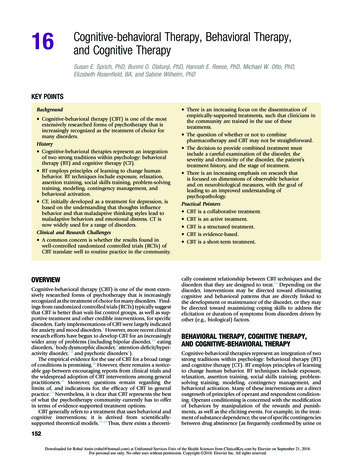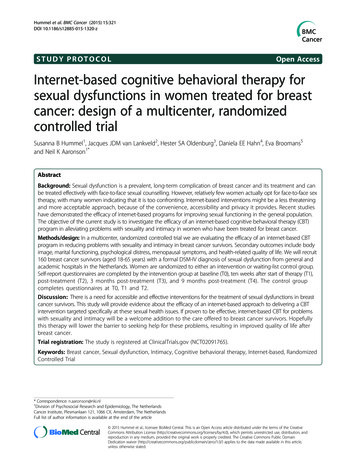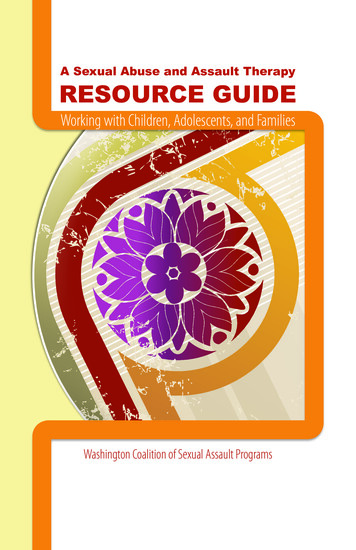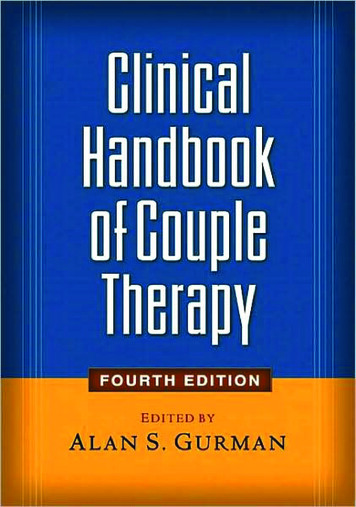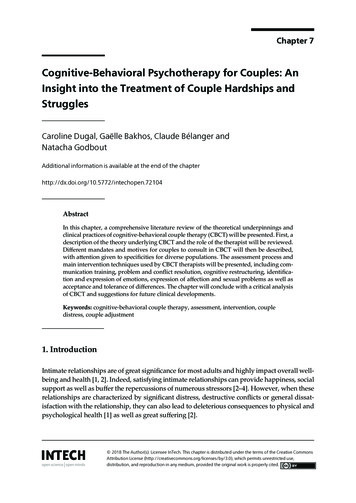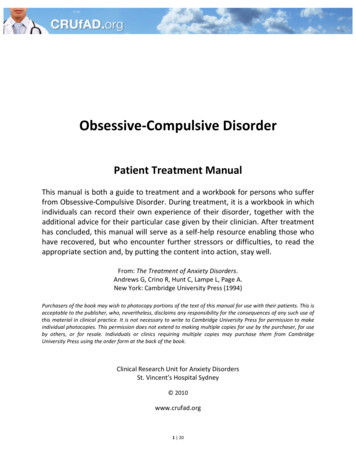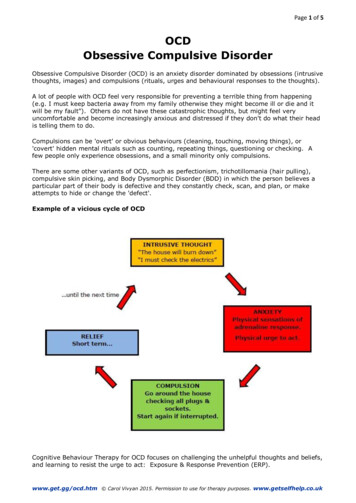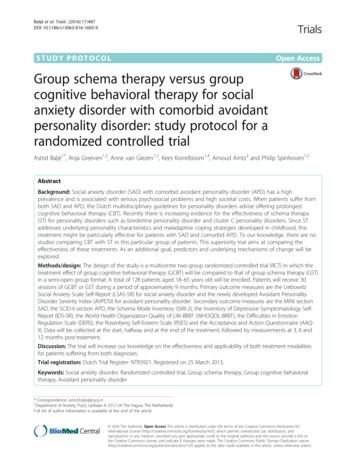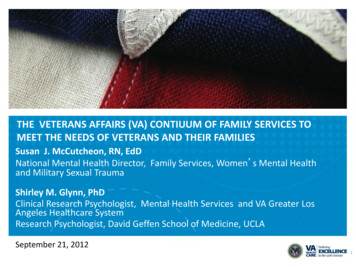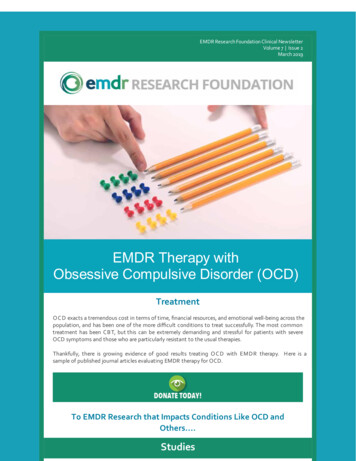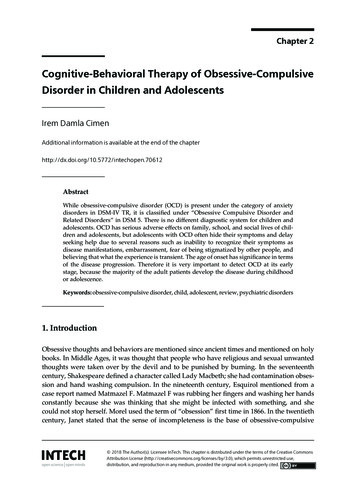
Transcription
DOI: 10.5772/intechopen.70612Provisional chapterChapter 2Cognitive-Behavioral Therapy of Obsessive-CompulsiveDisorder in Children andAdolescentsCognitive-BehavioralTherapyof Obsessive-CompulsiveDisorder in Children and AdolescentsIrem Damla CimenIremDamlaCimenAdditionalinformationis available at the end of the chapterAdditional information is available at the end of the bstractWhile obsessive-compulsive disorder (OCD) is present under the category of anxietydisorders in DSM-IV TR, it is classified under “Obsessive Compulsive Disorder andRelated Disorders” in DSM 5. There is no different diagnostic system for children andadolescents. OCD has serious adverse effects on family, school, and social lives of children and adolescents, but adolescents with OCD often hide their symptoms and delayseeking help due to several reasons such as inability to recognize their symptoms asdisease manifestations, embarrassment, fear of being stigmatized by other people, andbelieving that what the experience is transient. The age of onset has significance in termsof the disease progression. Therefore it is very important to detect OCD at its earlystage, because the majority of the adult patients develop the disease during childhoodor adolescence.Keywords: obsessive-compulsive disorder, child, adolescent, review, psychiatric disorders1. IntroductionObsessive thoughts and behaviors are mentioned since ancient times and mentioned on holybooks. In Middle Ages, it was thought that people who have religious and sexual unwantedthoughts were taken over by the devil and to be punished by burning. In the seventeenthcentury, Shakespeare defined a character called Lady Macbeth; she had contamination obsession and hand washing compulsion. In the nineteenth century, Esquirol mentioned from acase report named Matmazel F. Matmazel F was rubbing her fingers and washing her handsconstantly because she was thinking that she might be infected with something, and shecould not stop herself. Morel used the term of “obsession” first time in 1866. In the twentiethcentury, Janet stated that the sense of incompleteness is the base of obsessive-compulsive 2016 The Author(s). Licensee InTech. This chapter is distributed under the terms of the Creative Commons 2018 TheAuthor(s).Licensee InTech. This chapter is distributedwhichunderpermitsthe termsof the ommons.org/licenses/by/3.0),unrestricteduse, mons.org/licenses/by/3.0),whichpermits unrestricted use,andreproductionin anymedium, provided the original work is properlycited.distribution, and reproduction in any medium, provided the original work is properly cited.
28Cognitive Behavioral Therapy and Clinical Applicationsdisorder. Janet handled this disorder under the title of psikasteni and exhibited that ritualscould be improved by behavioral technics. S. Freud also stated the psychodynamic basis ofthe disorder [1].There are two basic classification systems in psychiatric disorders as the Diagnostic andStatistical Manual (DSM) and the International Classification of Diseases (ICD). Obsessivecompulsive disorder (OCD) has been included in ICD-5 first time among adult mental disorders in 1939, but for children OCD has been included in DSM-II among childhood mentaldisorders in 1968 and in ICD-9 in 1978 [2–4]. In DSM-IV, differences in childhood OCDpatients “like they could not know their obsessions and compulsions” are extremely unreasonable were highlighted [5]. While obsessive-compulsive disorder (OCD) is present underthe category of anxiety disorders in DSM-IV TR, it is classified under “Obsessive CompulsiveDisorder and Related Disorders” in DSM 5 and hoarding compulsions separated from OCDin DSM 5 into a new disorder, as “Hoarding Disorder.” But in the ICD 10 classification system, OCD is located under “neurotic, stress-related, and somatoform disorders” [6–8].Obsessive compulsive disorder and related disorders include: Obsessive-compulsive disorder (OCD) Body dysmorphic disorder Hoarding disorder Trichotillomania Excoriation (skin-picking) disorder Substance-/medication-induced obsessive-compulsive and related disorder Obsessive-compulsive and related disorder due to another medical condition Other specified obsessive-compulsive and related disorders and unspecified obsessivecompulsive and related disorders [8]OCD is a disorder that is characterized by the presence of obsessions and/or compulsions [8].Obsessions are intrusive and unwanted thoughts, urges, or images which are recurrent andpersistently experienced and caused anxiety or distress. Patients usually try to ignore or suppress these thoughts, urges, or images or try to neutralize them. Compulsions are behaviorsor mental acts which are repetitive and performed in response to an obsession or applied asrigid rules. These behaviors or mental acts are performed in order to prevent or reduce anxiety and distress or feared event or situations. These behaviors or mental acts are unrelatedwith feared events in reality. For this to be diagnosed, it should take a lot of time, for example,more than 1 h per day and cause clinically significant distress or impairment in functioninglike social, occupational, or other important areas. Symptoms of OCD must not be relatedwith any substance’s physiological effects, medical conditions, or mental disorders. In DSM 5diagnostic criteria, OCD could be specified as if with good or fair insight, with poor insight,and with absent insight/delusional beliefs or tic related [8]. Although there is no differentdiagnostic system for children and adolescents than the adults, it has been stated that young
Cognitive-Behavioral Therapy of Obsessive-Compulsive Disorder in Children and 612children may not be able to articulate the purposes of their compulsive behaviors or cognitiveactions [8]. Children usually have less insight about the irrationality of their obsessions andcompulsions. And at some developmental stages of children, it is hard to distinguish somenormative behaviors from OCD. At this point, behavior’s impact in child or adolescent’s functioning is important; normative behaviors usually do not affect functioning [9].2. EtiologyThe etiology of OCD is certainly unknown, but multiple factors like genetic, biological, cognitive, and behavioral are found effective [10]. Also it involves interactions between geneticand environmental factors [11]. Environmental factors such as traumatic life events and stresswere found to be effective in 50% of OCD cases [12, 13]. In a twin study, OCD concordancewas found approximately 90% in identical twins and 47% in dizygotic twins [14]. And in atwin study, genetic factors were found related with OCD symptoms [15]. In early onset OCDpatients, OCD may be almost twice as high through the relatives as late onset OCD patients.This shows that familiarity in early onset OCD patients is higher [16].OCD is a neuropsychiatric disorder, and basal ganglia dysfunction has been associated withobsessive-compulsive symptoms. In literature there are some studies that found association between OCD and neurological disorders like epilepsy, brain injury, Tourette’s syndrome, and Sydenham’s chorea [16–19]. Repetitive behaviors in a patient with Sydenhamcores were first described by Sir William Osler. During the course of Sydenham’s chorea,usually obsessive-compulsive symptoms occur [18, 20]. In literature it was reported thatimmunologically based group A beta-hemolytic streptococcal infection is an another etiological factor. This disorder is called as Pediatric Autoimmune Neuropsychiatric DiseasesAssociated to Streptococcal Infections (PANDAS). This disorder leads to an autoimmuneinflammation in the striatum and other brain areas and shows some neurologic symptomslike hyperactivity, choreiform movements, and tics. In addition to these, in a certain period,increase of obsessive-compulsive symptoms is observed. This makes researchers to thinkthat Tourette’s syndrome, Sydenham’s chorea, and OCD have a common etiology [21].OCD’s neural basis is thought to include the circuits of the orbitofrontal cortex, striatum,and thalamus and the neurotransmitters as serotonin, dopamine, glutamate, and gammaamino-butyric acid [22, 23].In recent neuroimaging studies, amygdala and prefrontal cortex’s role has been found important in mechanism of regulating emotional responses like fear and anxiety [24]. Some evidences showed that there is a reward dysfunction in OCD [25]. Similar to addictive behaviors,compulsive behaviors that cause relief from anxiety and have a rewarding effect were hypothesized. Reward process has been associated with ventral striatal orbitofrontal circuitry and inneuroimaging studies; it was shown that OCD patients had an altered metabolism in this areafrequently, and this results supported the hypothesis [26].As psychoanalytic theory, unresolved oedipal complexes cause anxiety, and this takes placea factor in OCD etiology. According to this theory, as a result of encountering anxiety, people29
30Cognitive Behavioral Therapy and Clinical Applicationshave a regression to anal period, and some defense mechanisms are commonly used like isolation, doing-undoing, reaction formation, and displacement [27].There is a little evidence about the cognitive mechanisms of OCD; it is thought that thesemechanisms are similar in adults and children. According to cognitive theory, the basis ofobsessions is catastrophic interpretation of unwanted and distressing thoughts, impulses, andimages. Obsessions are creating anxiety, and by rituals, ruminations, or avoidances, this anxiety is tried to be reduced. For obsession treatment these misinterpretations must be corrected.Also in a study, maternal cognitive biases are found more relevant with younger children’sOCD severity; personal cognitive biases are more relevant in adolescents [28].3. EpidemiologyPeople with OCD seek medical help when their daily functionality is seriously compromisedor they experience severe anxiety, and it has been reported that these individuals start seekingprofessional help after an average of 7 years from the onset of these symptoms. It was foundthat adolescents with OCD often hide their symptoms and delay seeking help due to severalreasons such as inability to recognize their symptoms as disease manifestations, embarrassment, fear of being stigmatized by other people, and believing that what they experience istransient [29, 30]. Furthermore, because adolescents hide their symptoms, it is difficult to determine the actual prevalence of the disorder, and when they seek professional help, they may bemisdiagnosed as depression or anxiety disorder due to not mentioning their symptoms [31].In the past few decades, knowledge of OCD has increased, but studies were mostly done inadult population and less studied in children. Although the first study about the prevalenceof OCD in children was reported in 1970, there are few population-based studies presentedabout the prevalence of OCD in children and adolescents recently [32]. The prevalence ofOCD in children and adolescents has been reported between 0.5 and 3% [33, 34]. In a recentstudy, in 16 European countries, median prevalence of OCD was found 0.7% [35].It is predicted that OCD is the fourth frequent psychiatric disorder after phobies, substanceuse disorder, and depression. Studies in different countries and cultures show that OCD prevalence is independent from cultures [27]. Previous epidemiological and clinical studies showthat OCD is more frequent among males prior to adolescence and during childhood, the difference between the sexes diminishes to a similar rate as the age advances, and the prevalencerate does not differ between sexes during adolescence and adulthood, and the rates are equalin both sexes at this time [36–46]. Although it was reported in the literature as early as 2 yearsof age, OCD usually begins at late childhood and early adolescence in youth. Age at onset ofthe OCD is averagely 10 years old, but age of diagnosis is around 13 years old [47]. Childhoodonset OCD’s onset age is approximately 8–11 years old in boys and 11–13 in girls [48].OCD has adverse effects on family, school, and social lives of children and adolescents [49,50]. The age of onset has significance in terms of the disease progression. Several studieshave detected that OCD often starts at late adolescence and early adulthood period [51, 52].
Cognitive-Behavioral Therapy of Obsessive-Compulsive Disorder in Children and 612Studies with adolescents showed that OCD development risk is higher at late adolescencethan early adolescence [53]. It is very important to detect OCD at its early stage, becausestudies indicate that 50% of the adult patients develop the disease during childhood or adolescence [47, 54–56].4. Clinical featuresIt is generally considered that in children obsessive thoughts are less common compared toadults; solely compulsive behaviors in the absence of obsessive thoughts are more frequent,while solely obsessive thinking is less common [45]. However, there are studies in literature showing that all children with compulsive aspect of the disease also have accompanying obsessions [57]. Some studies have reported that unlike adults, children may add theirfamilies in their rituals, and they cannot describe triggering factors and stressors as well asadults [42].According to literature, the most common obsessions among children and adolescentsinclude “fear of contamination, dirt, contracting disease”; “fear of aggressiveness, doingharm-receiving harm”; and “need for symmetry, order and precision”, while the most common compulsions are “grooming,” “repeating, and checking” [36, 37, 58, 59]. A study including 44 adolescents, 43 early onset adults, and 45 late onset adult OCD patients reported thatreligious and sexual obsessions are more common in adolescents than in adult patients,obsessions about contamination are more common in adolescents, and grooming compulsions are more frequent in early onset adults than adolescent patients [60]. Onset of OCD israre before 6 years old. But in cases that began before 6 years old, symptoms usually beganwith rituals or hand washing and checking [27]. Childhood OCD in boys is 1.5–2 times morethan girls [61]. In boys disorder is more severe, and neurological symptoms and comorbidities are more common [27].Studies that involved children and adolescents diagnosed with OCD reported the frequencyof poor insight with the range of 20–45%. Poor insight in children and adolescents with OCDis associated with severity of symptoms and loss of functionality and has a great influence onduration and success of treatment [62, 63]. Poor insight in OCD causes patients not to recognize their symptoms as a problem and results in reduced treatment motivation and treatmentsuccess. Therefore OCD patients with poor insight may be misdiagnosed or may not seektreatment [62, 64].5. AssessmentThe Children’s Yale-Brown Obsessive Compulsive Scale (CY-BOCS) is mostly using tooland often referring as the “gold standard” measurement for assessment of pediatric OCD. Itinvolves two subscales for Obsessions Severity and Compulsions Severity, and total scoreis estimating with these two subscales [65, 66]. Also there are some other assessment tools31
32Cognitive Behavioral Therapy and Clinical Applicationslike the Children’s Florida Obsessive Compulsive Inventory (C-FOCI), Leyton ObsessionalInventory-Child Version, the Anxiety Disorders Interview Schedule for DSM-IV: Child andParent Version (ADIS-C/P) which could be used for OCD assessment in pediatric population [67–69].6. ComorbiditiesAmong children with OCD, 85% of patients have at least one, and 21–75% have at least twoor more additional psychiatric diseases [70–73]. The most commonly reported accompanyingdiagnoses include anxiety disorder and depression [71, 72, 74]. Several studies involving children and adolescents have reported that attention deficit hyperactivity disorder, Tourette’sdisorder, oppositional defiant disorder, and generalized anxiety disorder are frequent comorbidities [75–78]. In addition to these accompanying disorders, eating disorders, especiallyanorexia nervosa, can be frequently observed concurrently with OCD in females [79]. Otherstudies have found association between early onset OCD and somatoform disorders, tic disorder, impulse control disorder, and high resistance to treatment [80–83].7. Differential diagnosisThere are many diagnoses that can be confused with OCD. For example, some anxiety disorders must be considered like generalized anxiety disorder, specific phobia, and social anxietydisorder. In generalized anxiety disorder, recurrent thoughts are usually about real-life concerns as finances and family, but in OCD these thoughts are irrational. Anxiety of patientswith specific phobia is more limited with specific objects or situations, and they do not haverituals or compulsions. In social anxiety disorder, fear is limited with social situations. Majordepression can be confused with OCD, but obsessions in major depression are usually appropriate with patients’ mood, not intrusive or distressing and not related with compulsivebehaviors. Some disorders that are under the category of OCD and related disorders like bodydysmorphic disorder, trichotillomania, and hoarding disorder can interfere with OCD. Inbody dysmorphic disorder, obsessions and compulsions are only with physical appearance;in trichotillomania there are no obsessions, and compulsive behaviors are only hair pulling.Hoarding disorder patients have difficulty in discarding or parting with possessions. In consequence objects extremely accumulate, but in OCD obsessions are not typically related withdispose of objects. Although obsessions and compulsions in anorexia nervosa are limited tobody image or weight, this disorder can be confused with OCD. Tic disorders also can bemisdiagnosed as OCD. Tics are not related with neutralizing obsessions, and tics are less complex than compulsions. Not only OCD but also psychotic disorder patients can have irrationalthoughts or delusional beliefs. But OCD patients do not have other psychotic symptoms andrecognize that the intrusive thoughts are a product of their own mind. Obsessive-compulsivepersonality disorder does not have specific obsessions or compulsions but have a resistantperfectionist or controller personality structure. OCD can be confused with some medical conditions because of the results of compulsions like eczema, rashes, and constipation [8, 9, 84].
Cognitive-Behavioral Therapy of Obsessive-Compulsive Disorder in Children and 6128. Treatment8.1. Cognitive behavioral therapyCognitive behavioral therapy (CBT) is recommended for the first-line treatment in mild tomoderate OCD, but in moderate to severe OCD cases, it is recommended to support CBT withmedication [85].CBT is a kind of psychotherapy which is developed on the basis of learning theories in psychology and the principles of cognitive psychology. The purpose of this therapy is to changeemotions and incompatible behaviors by using psychotherapeutic methods based on theseprinciples [86]. Behavioral therapies began to be used in the treatment of emotional andbehavioral problems of young people in the 1950s. These behavioral approaches are based onthe theories of Thorndike, Watson, and Bandura, and classical and operant conditioning havebeen used to treat behavioral disorders seen in infants and children. Cognitive therapies weredeveloped by Aaron Beck in the 1970s and started to be used in the treatment of child andadolescent cases in the 1980s [87].According to CBT, the mental condition of a person is the result of the mutual interaction ofthe environment, relationships, the biological structure, emotions, cognition, and behaviors.Psychotherapeutic methods can only be applied to cognition and behaviors of a person [86].According to learning theory, compulsions reduce distress that triggered by obsession so thatnegative reinforcement occurs over time (Figure 1) [88].Figure 1. The obsessive-compulsive cycle used by Piacentini et al. [89] to describe OCD’s mechanism.33
34Cognitive Behavioral Therapy and Clinical ApplicationsIn the CBT, children and adolescents learn to confront with their fears step by step. By learning how to behave against what the OCD tells them, they would understand that their fearsdo not reflect reality [90]. According to cognitive theory, cognitive processes determine thefeelings and behaviors of people. Cognitive processes provide one’s interpretation of theexternal world, surrounding events, own life, and relations with other people. When the basicassumptions and beliefs involved in the cognitive structure that determines the person’s viewof the world and its interpretations are distorted or functionally improper, a person begins toexperience problems [91]. Hence, problems that disturb the person are not due to the eventsand experiences themselves but due to perception and evaluation of the events and experiences [92]. Instead of these problematic forms of interpretation, cognitive therapy tries toreveal more compatible and appropriate perception and evaluation structures for a situation[93]. Additionally, cognitive therapy emphasizes that improper cognitive structures are animportant factor in emerging and maintaining mental disorders. The basic cognitive featuresof OCD are an overestimation of thoughts and feelings, exaggerated sense of responsibility,perfectionism about controls of thoughts and behaviors, and catastrophic interpretation ofpossible outcomes of thoughts and impulses, and these features lead to misinterpretations[21]. Cognitive therapy firstly tries to establish connections among emotion, behavior, andthought [94]. According to the cognitive theory, cognition is examined in two sets: automaticthoughts and schemes (Figure 2) [86].Cognitive therapy deals with automatic thoughts. These thoughts are spontaneous and locatedin the stream of mind. Also, they are cognitions that are mostly specific to environment andsituation that accompanied to moments of emotional distress. Contrary to emotions automaticthoughts are rarely noticed. These thoughts could be verbal or imaginary. There are unsaidFigure 2. Cognition structure [86].
Cognitive-Behavioral Therapy of Obsessive-Compulsive Disorder in Children and 612intermediate beliefs, rules, and assumptions regulating one’s behavior underlying automaticthoughts. These are permanent rules and anticipations about the behavior of himself/herselfand others, their life, and things that happened to them. Nonfunctional intermediate beliefslead the therapist to core beliefs that are the deepest cognitive structures. Core beliefs consistof people’s early life experiences and their identification with the people around them. Thesebeliefs are reinforced by similar experiences and learnings by time [95]. According to Piaget,the child enters the concrete operational stage around the age of 7–8. Most of the children atthe concrete operational stage have the logical processes to take advantage of the cognitivedebate. There may be difficulties in cognitive therapy in children who have not reached theconcrete operational stage [95]. Children and teenagers often apply to therapy by caregiver’sdecision. So the first thing to do by the therapists is to introduce themselves and to explain tothe child who they are, what they do, and how they can help [93].The most effective behavioral techniques are a combination of exposure and response prevention. Exposure to anxiety-producing stimulus is advised to a person, and decrease of anxiety is expected after repeated practices. During exposure, the person must prevent ritualsand avoidance behaviors. At this stage, response prevention is used. Practices can be in realor imaginary ways. A list should be made of the anxiety-inducing stimuli before practice.Practice starts with easy tasks in the list, and the difficulty of the tasks is increased step bystep [27, 96].CBT session consists of symptom control, review, and getting feedback of homework done;determines the agenda items; configures session content; and determines the new homework,[97]. CBT usually continue 10–14 weeks, with weekly sessions taking 45–90 min [98]. Amongthe basic principles of the CBT, the first step is psychoeducation. In psychoeducation session,the incidence and prevalence of OCD, age-dependent normal obsessive-compulsive behaviors, OCD’s symptoms and disorder’s nature in child and adolescent age group, OCD’s mechanism, and the impact of factors like developmental level and temperament are given. Also inthis session, knowledge of underlying reasons of OCD and basis of cognitive and behavioraltherapy, especially exposure and response prevention, and social learning theory, when themedical treatment is needed, are given.The second step is the diagnostic assessment. There must be a detailed assessment of child’s/adolescent’s problem and history of coping methods and medical, developmental, family,and school features. Social and cultural characteristics must be considered. Different sourcesof information such as the clinical interview, parents, questionnaires, and information fromschool must be integrated. Specific OCD symptoms and comorbidities should be asked. A formulation should be made including protective, precipitating, predisposing, and maintainingfactors linked to child/adolescent’s situation. The decision should be given about whether anadditional medical treatment is necessary. A family assessment involving the capacity to support the child/adolescent of the family should be undertaken. Which family members havebecome involved in rituals, avoidance behaviors, and obsessions and family functioning mustbe questioned.In the third step, emotions, behaviors, and cognitions should be assessed. Anxiety shouldbe explained and normalized in ordinary fear-inducing situations. Furthermore, thoughts,35
36Cognitive Behavioral Therapy and Clinical Applicationsfeelings, and behaviors should be assessed. Detailed list of obsessive ideas and rituals shouldbe done by standardized instruments. Insight level should be questioned. A list of triggers toobsessional fears and compulsive behaviors/rituals and avoided situations should be generated. Cognitive and behavioral rituals used to reduce discomfort should be identified. Byusing scales appropriate for the age such as “fear thermometer” or “SUDS ratings” anxietylevels should be rated, and child/adolescent should rate how difficult to resist OCD symptoms. For exposure and response prevention, targets should be identified.The next step is intervention stage. At this step, OCD and intervention rationale shouldbe explained. OCD could be explained by age-appropriate metaphors. With positive reinforcement like praise, awards, and “certificates of achievement,” engagement to therapyshould be increased. OCD symptoms are tried to be externalized by giving a nicknameto OCD, using “boss back OCD” strategy, being child/adolescent’s ally in fighting OCDand figuring out strategies for fighting OCD. Constructive self-talk might be helpful forcoping, and cognitive reconstruction would be useful for unhelpful assumptions underlying the obsessions. In the exposure trials, a child/an adolescent creates a hierarchic listof anxiety situations. Mutually agreed targets are chosen from the list, and those targetsare worked together. A direct exposure method is implemented on the agreed targets,and enough exposure time is allowed for habituation. In this process, anxiety levels arerated. Graded exposure including imaginal exposure, exposure to cartoons or images ofthe feared trigger, is used in the session [99]. The exposure trial is continued until distressratings decrease by 50% [100]. By agreeing on realizable daily homework tasks, chances ofsuccess are maximized.For ritual prevention, a plan will be made as delaying, shortening, doing differently orperforming the ritual slowly. Also, self-monitoring and recording rituals are a part of theexposure process. During response prevention, child’s/adolescent’s anxiety is measured bythe fear thermometer. Then relapse prevention is used. The distinction between “lapse”and “relapse” is explained to child/adolescent and parents. For any future OCD symptoms, a rehearsal is made for remembering and using CBT techniques. Family members areincluded in the intervention as “coaches” for supporting children during exercises, and it isimportant to work with the school [99]. When CBT is implemented, escape, avoidance, andsecurity search behaviors must be considered because these behaviors are the factors leading to anxiety [101].Child/adolescent is trained for some anxiety management strategies like breathing and relaxation techniques [102]. CBT could be implemented in groups. Studies show that group CBTprograms are more comfortable for patient children because of seeing other children with thesame problem [90]. The developmental characteristics as a level of autonomy and dependenceof the child should also be considered when CBT is applied [101]. The level of language development during therapy can cause problems. They may not express their feelings verbally.For this reason, first of all, emotional words and concepts should be studied with comics,pictures, heroes, and narratives [93]. And cognitive behavioral play therapy can be appliedwhile working with very young children [101].
Cognitive-Behavioral Therapy of Obsessive-Compulsive Disorder in Children and 6128.2. Medical treatmentIn OCD’s pharmacological tr
Cognitive-Behavioral Therapy of Obsessive-Compulsive Disorder in Children and Adolescents . like social, occupational, or other important areas. . According to this theory, as a result of encountering anxiety, people Cognitive-Behavioral Therapy of Obsessive-Compuls
